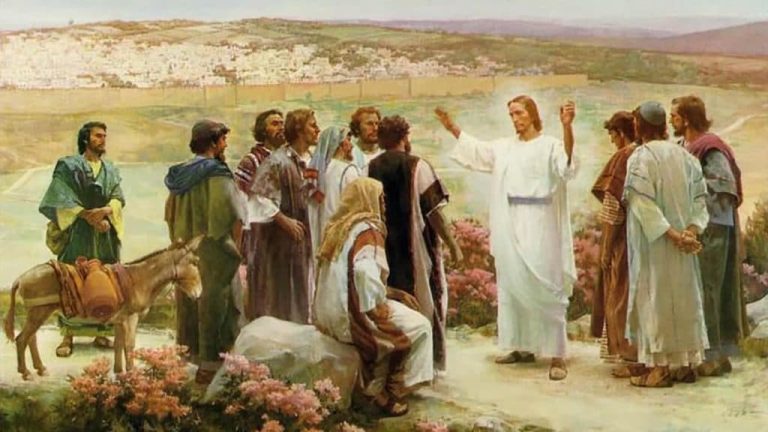What are the Gospels of the Bible? and its Origins
The Gospels , is the term given to the 4 books of the apostles and disciples of the Lord Jesus, which were with him from the time they were chosen until the crucifixion of the Lord. Discover in the following article which are these books known as the gospels of the New Testament, what they are called and much more.
The gospel
The Gospel is a term that comes from the Latin language known as evangelĭum, this word is related to the Greek εὐαγγέλιον, in this sense it is identified as (euangelion), whose meaning is to give (good news), for this reason it can be said that the The gospel is based on the good news that comes directly from God as a divine act.
It is known that the gospel consists of transmitting to every person the message of salvation which is based on the life and work of Jesus, thus showing the wonders that God performed through his son, and the immense love that he showed to all mankind. mankind by delivering them from damnation and granting them eternal life.
In general, it is about the complete story of the life of Jesus and the importance of each of his teachings, as well as the fulfillment of God’s promises with his servants Abraham, Isaac and Jacob, to whom he told them that he would take care of them. to redeem his descendants, and in this way he would free them from sin, by delivering his only-begotten Son Jesus Christ for LOVE, and that through this divine act all those who by faith believe in him can be saved.
In this way the word spoken by the Lord God himself is fulfilled, and also by his beloved son the Lord Jesus Christ who dies in order to free all humanity from sin and thus be able to give them eternal life, at the time of resurrection. On the third day, the Lord shows his immense power and to be able to give repentance and forgiveness of all sins to everyone who truly believes in him.
The king and psalmist David prophesied that Jesus would rise on the third day without seeing corruption; David died and his body did not see corruption and his tomb is on Mount Zion, however, the Lord Jesus rose on the third day, he reaches the fulfillment of the prophecy of his resurrection and also his tomb or sepulcher is completely empty. and in this way it is known as the Holy Sepulchre. This is the gospel that all the early disciples of the Lord Jesus used to preach.
In a much more general sense, the term gospel can even refer to the gospels, which are usually written by the first Christians who go to collect the original preaching of the disciples of the Lord Jesus of Nazareth. Being the main core of his message what is the .
It is about 4 gospels that are contained in the New Testament of the evangelical Christian Bible, which are called the canonical gospels, and in this way they are usually recognized as part of the Revelation by the various Christian confessions. These gospels are characterized by bearing the name of their own authors, that is, Matthew, Mark, Luke and John.
The vast majority of experts usually consider that these 4 gospels were written between the years 65 and 100 AD. C., despite the fact that many of the other experts are those who propose earlier classes of dates. There are also other writings, which are usually known as the apocryphal gospels, these are those not recognized as canonical by the Christian churches of today, in this way that these apocryphal gospels are not considered as reliable, nor as the inspired texts for the divinity.
However, they did come to be considered as the “writing” by certain of the factions where Christianity is usually divided during the first centuries of its history, especially by the Gnostic current, thus contributing a large part of said texts, and by the various that retained a much closer kind of bond with the Jewish tradition from which Christianity grew.
This one that we have mentioned last is established as the gospel of the Hebrews and is also known as the secret gospel of the apostle Mark, this classification arises from the different authors (such as Morton Smith himself) who date as the contemporaries of the canonical gospels themselves and still as a source for certain of these.
Because of this type of debate or controversy, there are authors who are inclined to mention more the “extra-canonical gospels”, instead of the “apocryphal”, in order to avoid a type of term that usually implies the priority of the falsity of the gospels. texts. The Gospel of Thomas according to the Catholic Church tends to be even dated by certain experts in the year 50 AD. C, a kind of hypothesis that will make it the oldest known.
the gospels
The final moment of the divine Revelation to humanity shows the immense love of God through the Incarnation of his only son. The story of that wonderful salvific work of the Lord Jesus, which is taught out loud by all the Apostles and is also continuously delivered in the Sacred Tradition of the Church, has been recorded in writing once and for all, under the inspiration of the The Holy Spirit himself, in the books of the New Testament, just as in those in which the word of God reaches its culmination.
The New Testament begins its writings with about 4 books that have the same title: “Gospel”; They are also inspired that the remaining books of the Word of God are the most excellent of all of them, because they are the ones that constitute the main testimony about life and also the doctrine of the Word that was made flesh, our beloved Savior. These 4 books managed to be designated with the title of “Gospel” from the beginning of the second century.
The word “gospel” is usually of Greek origin, which originally means “good news”. It was also used in Greek antiquity to indicate the reward given to the bearer of that kind of good news.
When Our Lord, from the beginning of his public ministry, offers a direct invitation to all so that they may believe in the Gospel, he refers to the good news of the advent of the Kingdom of God on earth which He announces, and that with Himself. In this way, the Gospel that the Apostles always proclaimed is usually the announcement of the good news, which is the Lord Jesus Christ himself.
What are the Gospels?
The Gospels consist of about 4 books that can be found in the New Testament that are the ones that record the stories of what the Lord Jesus said and also did. They were, most likely, all of them produced in the second half of what was the first century, already around the 60s.
Although certain great scholars are those who date the Gospel of John to the end of the first century in what is the decade of the 90s, others are those who suggest a date that is much earlier for its composition. Interestingly, the oldest extant text of the New Testament happens to be a fragment of the Gospel of John, which dates to around AD 125.
Although the Gospels came first in the New Testament sequence, they were all written after certain letters of the apostle Paul. These letters are the earliest documents in the New Testament, which are those dating from about AD 49 to the years 50. In the first letters of the apostle Paul, he refers to the important events that occurred after the death of Jesus, as well as the burial and resurrection.
However, the Gospels are the ones that provide a very detailed kind of information about all those events that are not found in any of the later books that are part of the New Testament. In addition, the Gospels are the ones that contain very close information about the birth of Jesus, as well as his ministry and therefore they are established as fundamental sources for any kind of attempt to reconstruct the life of Jesus of Nazareth.
Origin of the Term
The word “gospel” is used for the first time in the writings in the course of the first Christian communities by the same of the well-known apostle Paul of Tarsus, in the first letter to the Corinthian church, which was probably written in the year 57 which reads as follows:
The previous text belongs to the original language in which the letter was transcribed, being the Hebrew language, its translation and in this way it is manifested in our Castilian language, which in this sense is:
“I remind you, brothers, of the gospel that I announced to you, that you received, and in which you have persevered.”
The Gospel consists of the entire life story and also the teachings of the Lord Jesus. He also gets to talk about the love that God has shown and shows for all humanity by sending his only Son Jesus Christ to be able to redeem the world. That’s how he dies for all our sins; then he is buried and on the third day he defeats death and rises from the dead according to what he himself had declared to his disciples.
Later, he is presented to the 11 apostles (it is said 11 because Judas Iscariot was no longer with them, in addition, other people were also in the place, such as the mother of Jesus, Mary Magdalene and others), by the course of about 40 days.
With his death, all the bonds of love that had been broken since the disobedience of the first Man on earth, who was Adam and Eve, were restored, and the gates of heaven were opened again (which even at that very moment were closed) in great benefit of all those who continue with his word, this can be “The love of God above all things and the love of the neighbor as oneself”.
With this same “sense” appears what the word is in the Gospel of Matthew and also in the Gospel of Mark. Probably this word becomes the translation into the Greek language of a class of expression in the Aramaic language which is usually used in his preaching by Jesus of Nazareth himself, however, there is no conclusive data regarding this.
In total, the expression of the term “gospel” is usually used in about 76 times which can be observed in the New Testament of the Bible. It becomes very significant that about 60 of them are those that take place in the letters of the apostle Paul, and that there is no mention of the term in the gospel of the book of John and also in the Gospel of Luke, despite that does appear in the Acts of the Apostles, they are attributed to Luke. The number of mentions of each of this term is usually as follows:
- Term: Gospel (euangelion)
- Gospel of Matthew: 4
- Gospel of Mark: 8
- Gospel of Luke: 0
- Acts of the Apostles: 2
- Gospel of John: 0
Now let’s see the case with the Term of Evangelizing, which is distributed in the Bible in the part of the New Testament in the following way:
- Term: Evangelize ( euangelízō )
- Gospel of Matthew: 1
- Gospel of Mark: 0
- Gospel of Luke: 10
- Acts of the Apostles: 15
- Gospel of John: 0
It has been speculated as to whether the Hellenistic Christian communities were the ones that adopted the term ” the gospels of the bible ” from the cult of the emperor. There is usually in the region of Priene a kind of inscription, which is dated in the year 9 a. C., in which this kind of word appears with a type of meaning very similar to the one that Christians later came to give it.
In any case, the word of God had managed to be constantly used in the previous literature in the Greek language, among which are included the first translation of the Bible into this same language, which is usually known as the Bible of the Seventy .
Canonical Gospels
Of the high number of gospels that were written in ancient times, only about 4 of them came to be accepted or admitted by the Church and were also considered as the canonical gospels. Establishing them as canonical to these 4 Gospels became a central concern of Irenaeus of Lyons, approximately in the year 185.
In his most important work, entitled Adversus haereses, Irenaeus was the man who harshly criticized both all the Christian communities that made use of only one gospel, that of the book of Matthew, and those who came to accept various of those that are currently considered as the apocryphal gospels, as a kind of Gnostic sect of the Valentinians.
Irenaeus himself was the one who affirmed that the 4 Gospels defended by him became the 4 pillars of the Church. “It cannot be possible that they can be neither more nor less than the 4”, was what he declared, presenting as a kind of logic the analogy with the 4 cardinal points, or also with the 4 winds.
In order to illustrate his point of view, he used an image, which was taken from the book of Ezekiel 1, of the throne of God which is flanked by some 4 creatures with faces of various animals (man, a lion, a bull, an eagle) , which are at the origin of all the symbols of the 4 evangelists in current Christian iconography.
About 3 of the canonical gospels, which are Mark, Matthew and Luke, are the ones that present important similarities to each other. Due to the equality that they keep between them, they are called synoptic since, in the year 1776, the scholar called JJ Griesbach published them for the first time within a table of 3 columns, in which they could be covered globally from 1 single look that is “synopsis”, which is known as “joint view”, for a better way to highlight your matches.
Origin of the Canonical Gospels
The history of the development of the 4 gospels is often considered a bit confusing, there having been various kinds of theories about their composition, as is usually explained below. The analyzes of the different scholars throughout the world have been able to focus on what is called the synoptic problem, that is, on the literary relationships that exist between the 3 synoptic gospels, which are Matthew, Luke and Mark. The theory that has managed to obtain the greatest consensus in all of history is the so-called “Two-Source Theory”.
Two-Source Theory
The differences and also the similarities between the synoptic gospels have been able to be explained in different ways. One of the theories that has not been proven is usually the so-called “two-source theory”. According to this kind of theory, the book of Mark is the one that could be the oldest gospel of the 3, and that it would have been used as a kind of source by Matthew and Luke themselves, which can even explain the great number of texts, writings or material common to the 3 synoptics, however, since the gospels are written in different times and places, there would be no support for this.
Between the books of Luke and Matthew it has been possible to observe the coincidences that do not appear in the book of Mark and that have been attributed to a class of hypothetical Q source that from the German language is Quelle, which translates to Q source or protoevangelium. , that it is the one that would basically consist of a kind of series of lodges “sayings”, that is, in the “teachings” of the Lord Jesus, without any kind of narrative elements.
The discovery in the Nag Hammadi of the Gospel of Thomas, is usually a compilation of sayings attributed to the beloved Lord Jesus, which contributes to consolidate what is the hypothesis of the existence of the Q source. The existence of Q came to be defended by the great and numerous Protestant theologians like Weisse, and also like Holtzmann, and managed to be developed later by one called Wernle, as well as by Streeter, who was the one who came to postulate the 4 sources (Mark, Q, and 2 other , which called as M, L and also J. Schmid.
However, for 2 people named Dibelius and Bornkann it was possible to deal with a kind of oral tradition, it is most likely that it used to be a kind of written source, given the kind of coincidence generally in a literal way between the Gospels of Matthew and of Lucas. Likewise, it has been possible to consider as probable that the protoevangelium Q came to be written in the Aramaic language, and that it was later translated into the Greek language.
Although the Q source becomes a kind of hypothesis of the scholars to try to explain the synoptic problem, this kind of collection of sayings of the Lord Jesus in the same way is known modernly as the Lodge which was of the reading and also from daily study in the early church and the book of Luke is the one that mentions it in the Acts of the Apostles as “The Words of the Lord” . In such a way that the hypothesis of Q and also of the Lodge is what acquires its substance.
Other Theories
There are other kinds of hypotheses that are those that dispense with the existence of a source Q. Of these, some of them are those that affirm the temporal priority of the book of Matthew and others are those that consider that Mark became the first. gospel. The most prominent are usually the following:
The hypothesis that is proposed by a man named Farrer is that the Gospel of Mark was first written down and later used as a source for the books of Matthew. In the book of Luke, in a third stage, the 2 would have come to be used as species of sources.
The hypothesis of a man named Griesbach is one that gives priority to the gospel of the book of Matthew. The book of Luke would have come to use it as source species, and finally, the book of Mark would have managed to make use of the 2 precedents. This was the proposal by the same Johann Jakob Griesbach in the year 1789.
The Augustinian hypothesis is one that maintains that the book of Matthew managed to be the first gospel created, followed by the book of Mark and Luke, and that each of the evangelists used the precedent as a source. This is usually the theory that best explains all the approaches of the Fathers of the Church, and also the most frequent in the Catholic tradition.
The hypothesis of the Essenes is the one that maintains that it was this group who managed to write and was also the one who compiled most of all the writings of the life of Jesus and is the one who started the gospel of Q. The hypothesis de Goinheix is the one that says that the first gospel that circulated in a true way became that of Matthew in the Aramaic language. Continuing with what is the narrative of this, and also helping with the document that we call Q or also Logia, Mark and later Luke are the ones who write their respective gospels.
Later, that the book of Matthew, is usually about 2 gospels, this is translated into Greek and is the one that takes the elements of all those. Finally, it is the book of John that makes known the gospel that he came to be writing for many years in Jerusalem first and in Ephesus finally.
Gospel According to John
The book of John becomes without a doubt the last of all the evangelists, the canonical gospels, of a date that is considerably later than the synoptics. In it, miracles are not usually presented as such but rather as “signs”, that is, gestures that have a much deeper meaning: revealing the glory of Jesus.
The hypothesis that came to be elaborated by Rudolf Bultmann is the one that postulates that the author of this gospel came to have at his disposal a kind of source, oral or also written, on the so-called “signs” of Christ, independently of the synoptic gospels, which has come to be called the Gospel of Signs, of which existence is a merely hypothetical one.
Authorship of the Canonical Gospels
Traditionally, the authorship of the gospels is usually attributed only to the Apostle Matthew, the apostle of Jesus, also to Mark, the disciple of Peter, to Luke, the doctor who is of Syrian origin who was the disciple of Paul of Tarsus and finally to John, the apostle of Jesus. However, until now there has not been a certain authorship yet in a real way for each gospel.
Within the Catholic Church, what is known as the Second Vatican Council in its Constitution Dei Verbum went so far as to point out that “the Church at all times has defended and defends that the 4 gospels have an apostolic origin.
For what the Apostles always preached by mandate of the Lord Jesus Christ, later, under the inspiration of the great Holy Spirit, they and the apostolic men were the ones who transmitted it to us through the scriptures, the foundation of faith, this means, the gospel in about 4 redactions, according to what the books of Matthew, Mark, Luke and John say “ .
Dates of the Canonical Gospels
There is no information on the exact dates on which they were to be written. The vast majority of experts are those who consider that the canonical gospels were written in the second half of the first century AD. C., approximately half a century after the disappearance of the Lord Jesus of Nazareth, although many of the same experts are those who consider that these were written before the destruction of the Temple of Jerusalem.
There is also a class of minority who are those who propose that the gospels came to be written after the final destruction of Jerusalem during the reign of Hadrian.
Raymond E. Brown, in his book “An Introduction to the New Testament”, is the one that considers that the most accepted dates are usually the following:
- The Book of Mark: It was written in the year 68 to 73 c.
- The Book of Matthew: This was written in the year c. 70 to 100 (although certain authors, who do not accept Mark’s priority, place him in terms of his writing at a date prior to the year 70).
- The Book of Luke: It was written in the year c. 80 to 100 (a large part of the scholars usually date it around the 85 years).
- The Book of John: It was written in the year c. 90 to 110 (a date proposed by CK Barrett; RE Brown is not the one that offers a consensus date for the Gospel of John).
All these dates are based on what is the analysis of the texts and also in terms of their relationship with other sources of information that have been had over time.
Harmonization and Concordism
“Harmonization” became a type of resource used when looking for a way to “force” the texts of the gospels that seem to contradict each other or that do not fully agree with each other, so that it may seem that they all express the same thing. . From that same moment is that the name of “harmonic problem” appears, with which he referred to the great difficulty to be able to gather the 4 evangelical stories in just 1.
One of the most famous examples was the “Diatéssaron”, a Greek name that could be translated as “formed by four”. This is a kind of Greek work that is written between the years 165 and 170 by the same Syrian author Tatian, which comes to consist of only 1 gospel which is composed of various elements taken from the 4 canonical gospels, and possibly in the same way from certain apocryphal sources.
Tatian was the one who eliminated the repetitions and managed to harmonize all the texts together in order to hide the possible discrepancies found between the gospels. The “concordism” was another resource that was used when some of the biblical texts in general, which can be seen reflected some scientific concepts of times or times in which the sciences were much less developed than today, are presented in a different way. a forced form so that they can express the same thing that science says today.
Apocryphal Gospels
The Apocryphal Gospels or also known as the extra-canonical ones consist of the books or writings that emerged in the first centuries of Christianity around the figure of Jesus of Nazareth that were neither included nor accepted in the canon of the Jewish Tanakh of the Hebrew – Aramaic, of the Bible of the Israelites Septuagint of Greek origin, as well as not even in any of the versions of the Bible that are used by the various groups of Christians as it becomes:
- The Catholic Church
- The Orthodox Church
- The Anglican Communion
- The Evangelical or Protestant Christian Churches.
Among these writings are the Nag Hammadi Manuscripts. The apocryphal term from the Greek: από, which means “far” and κρυφος which means “hidden”, which originally usually means “hide away”, and after drifting into “hidden”, “dark”, has been used by means of of the times in history to be able to make reference to certain collections of texts and also of sacred religious writings that have arisen and emanated in the Jewish or Christian contexts. Let’s see some books, texts and writings that are part of these:
Fragmentary Texts
Among the Fragmentary texts that make up The Apocryphal Gospels are the following:
- Gospel of the Hebrews
- Greek Gospel of the Egyptians
- Gospel of Marcion
- Secret Gospel of Mark
- Gospel of Jude
- Gospel of Mary Magdalene
- Gospel of the wife of Jesus
- Oxyrhynchus Fragments
Nativity Apocrypha
Among the Apocrypha of the Nativity that usually compose or form part of the Apocryphal Gospels are the following:
- Protoevangelium of James
- Gospel of Pseudo Matthew
- Book on the Nativity of Mary
- Liberation of Infantia Salvatoris
Apocrypha of Childhood
Among the Apocrypha of the Infancy that usually compose or form part of the Apocryphal Gospels are the following:
- Gospel of Pseudo Thomas
- arabic infancy gospel
- Story of Joseph the Carpenter
- armenian infancy gospel
- Book about the childhood of the Savior
Apocrypha of the Passion and Resurrection
Among the Apocrypha of the Passion and Resurrection that usually compose or form part of the Apocryphal Gospels are the following:
- Gospel of Peter
- Acts of Pilate
- Gospel of Bartholomew
Nag Hammadi Gnostic Apocrypha
Among the Nag Hammadi Gnostic Apocrypha that usually compose or are part of the Apocryphal Gospels, the following can be found:
- Gospel of Thomas
- Gospel of Philip
- Gospel of Nicodemus




![One of the questions that every Christian frequently asks himself or not is who created God? It seems elementary to think, if everything has a beginning and an end, why not God? Thanks to this article you will be able to learn in a simple and easy way everything about who created God, the Bible, the church and much more, do not stop reading it. who created god Table of Contents [ Hide ] 1 Who created God? 1.1 Logical arguments 1.2 Causes that originated the universe 2 Who created God according to the bible and how long did it take him to create the universe? 2.1 Did God rely on evolutionary theory? 2.2 Defenders of what is written in the Bible Who created God? Thinking or saying that something or someone else created God, undoubtedly also involves asking the question of what other person, thing or entity gave rise to that by which we have God present in our lives. But necessarily the debate of ideas is opened, that something else created what, that resulted in the creation of the architect of the universe, but it is an endless story to ask this series of questions or doubts regarding the origin of everything that we know today. Considering the theory of self-creation as something tacit, without the right to self-reflection or self-criticism, is something very absurd. That is, to think of who created God if he created himself implies that he existed before he existed, something illogical, right? That is why it is complex and difficult to find an answer with which we are all satisfied. Evolutionary biologist Richard Dawkins opposes his theory based on evolution mainly as a product of genes, to the creationist theory defended by biblical theologians for centuries, where it is argued that God has always existed and is eternal. On the other hand, if we consider establishing conclusions from philosophical or deductive reasoning, using the syllogism from three premises that may or may not be valid for the defenders or detractors of the creationist theory, we can get closer to having lights of understanding of this complex topic. For example, let us start from the following premises: Bearing in mind that there was a time when absolutely nothing existed, then nothing could exist today. There is something now. Therefore, there never was a time when nothing ever existed. Analyzing each of the three statements, a very brief critical analysis can be obtained that there has never been a time, era or time when no creation could ever be observed in the universe, that is to say that there was always some presence of something, even if it were a small particle in the universe. It is somewhat difficult to understand, we do not stop to ask ourselves the question of who created God?, and we simply take for granted that there was always, always something before now. logical arguments From the point of view of a theologian, a believer, a practitioner of the Christian religion, there has always been a God who is eternal and spiritual, who has an appearance of omnipresence, he did not create himself, in conclusion, he does not admit arguments regarding the eternity of God. God. Each of the fields of knowledge that defend their positions about, who created God?, tries to find explanations for each of them. For example: In the area of archeology, if during an excavation they came across objects similar to spearheads, ax heads or pieces of vessels, they would surely say that these objects are not the product of sedimentation or rearrangement processes of tectonic plates, but rather, it is the result of the advance of the groups of the human race, without giving a logical explanation of what or what were the reasons why those objects ended up in that place. Experts on space issues, when making a space expedition on their way, will observe remains of machinery, on the back of the moon, their argument would be that all this is the result of beings provided with extraterrestrial intelligence, without knowing precisely what who are they and how did they manage to leave those machines there on the moon. As you can see, each one defends their position without giving the other a respite, it is simply my truth and I accept it as true. It does not give the right to explanations of what has already been explained. Getting involved in an endless debate is not good for anyone, explaining the genesis of the creator God is a topic with many edges and meters of fabric to cut. Causes that originated the universe For the fervent believers in the holy scriptures, what gave rise to the universe was due to an immaterial cause, that is, something non-tangible since, if it had been produced by a tangible cause, it would be affected by the same forces that generate the deterioration of the planet. . For these reasons, according to theologians, it is asserted that the beginning of the universe was due to a super natural cause, in other words, nothing material or spiritual intervened, something that goes beyond time, matter and space acted. In short, the power of the infinite spirit had to intervene. On the other hand, the reason why the universe was created is due to the intervention of an extremely powerful force, just stop to observe the magnificence and energy that are scattered throughout the universe. The bible tells the story of a God who is the creator of the universe, but what is not said is who created God? According to the bible , he has three properties that distinguish him, these are: It is eternal Account that appears in the Book of Psalms, chapter 90, verse 2 "Before the mountains were born and you formed the earth and the world, from the century and to the century, you are God" Omnipotent It is outlined in the 29th chapter of Chronicles, in the 11th and 12th verses “Yours are, Lord, the greatness and the power, the glory, the victory and the majesty. Yours is all that is in heaven and on earth. Yours too is the kingdom, and you are above it all.” “From you come wealth and honor; you rule everything. In your hands are strength and power, and it is you who magnifies and strengthens everyone. it is immaterial This quality can be found in the book of John in its chapter 4, verse 24 and in the book of Genesis chapter 1 verse 1. “God is Spirit; and those who worship him must worship in spirit and in truth." Juan 4:24 “In the beginning God created the heavens and the earth” Genesis 1:1 who created god Who created God according to the bible and how long did it take him to create the universe? The Bible states that God first created the heavens and the earth. It is what we have been taught for centuries, and seen from a critical point of view it is a very ambiguous, vague statement, as well as having a very general character. In it, no specification is made of how much time God used to be able to complete his work of creating the universe. On the other hand, those who favor the creationist theory are fully convinced that it took God six days to create the universe. An idea that of course is not shared by those who base their knowledge on scientific work, that is, those whose only reasoning is centered on science and does not admit any other truth that comes from sources other than science. The bible does not state, nor does it mention, the statements made by pro-creationists and fundamentalist defenders, in which it is intuited that the days that were used for the creation of the universe actually lasted twenty-four hours each. . In the Bible the term day is used to refer to certain periods of time, but whose duration is not specified. For this reason it is very valid to believe that the days of creation could have lasted for thousands of years. Did God rely on evolutionary theory? On the planet there are millions of people who do not believe in the Bible and do not practice what it teaches. They also believe that life is the product of chance, and that it was generated as a result of the combination of a set of inert chemical compounds that could be combined and transformed through undisclosed processes. Many of its defenders believe that there was a time when an organism or bacterium was created by itself that was capable of cloning itself. And that with the passage of time it underwent a metamorphosis until it became the species that currently exist. For a group of people this idea is somewhat absurd, since it would be impossible to believe that man with his complex system comes from a bacterium. Another group of people who are in favor of defending what is said in the theory of evolution, but who are also believers in the holy scriptures. They take it for granted that God created the earth, all life on and below it, and then assumed a role of supervisor or director of creation and its process of evolution. But the latter is not mentioned in the Bible in any of its books. Defenders of what is written in the Bible It is written in the bible and it is very significant, that Yahweh created all kinds of plants, flowers and animals, he also made men and then women, provided them with self-awareness and with the greatest capacity to love and proceed wisely and fairly. It is logical to think that over the years these species of plants and animals that were created by God have undergone a series of transformations in order to adapt to the changes that have occurred on the planet, giving rise to very marked differences with respect to to the species of genesis. Because what is expressed in the biblical scriptures, does not oppose the scientific objections of the variations that have been generated within the genera and species.](https://thefearlab.com/wp-content/uploads/2022/10/quien-creo-a-dios-5-768x422.jpg)


